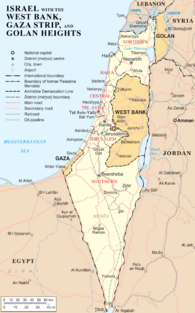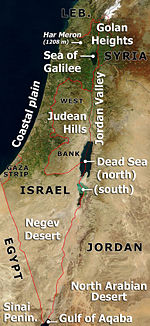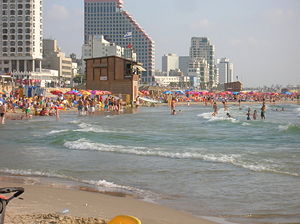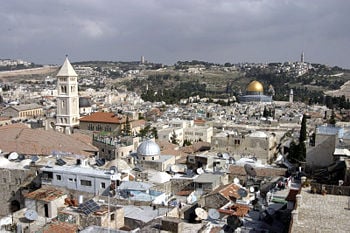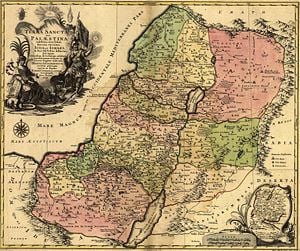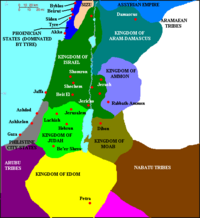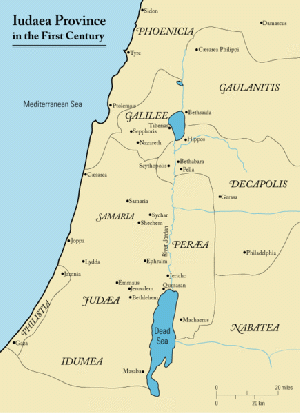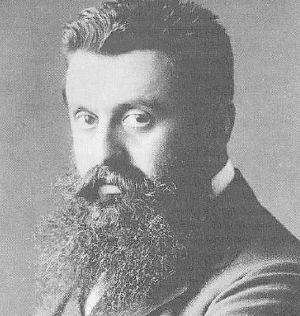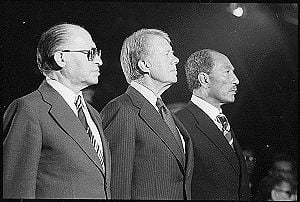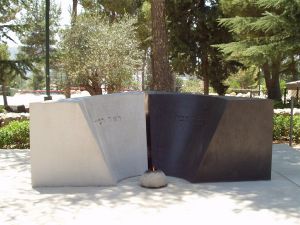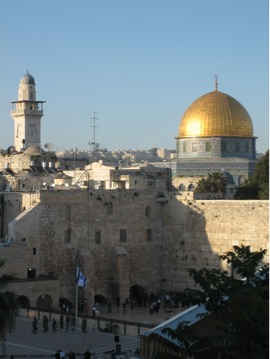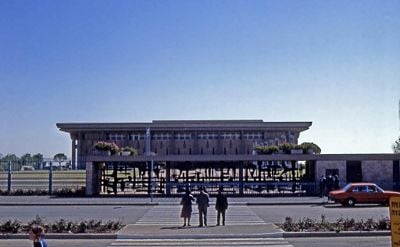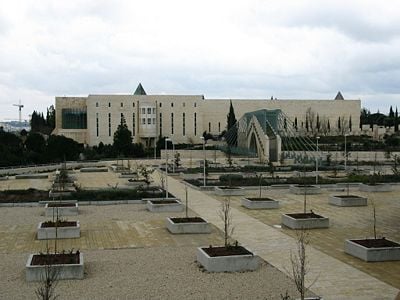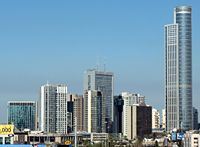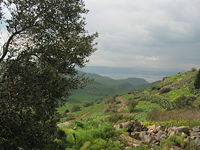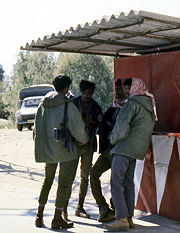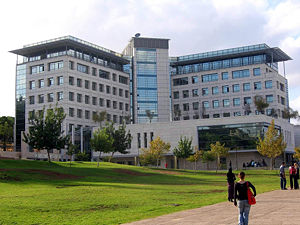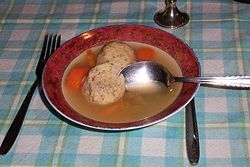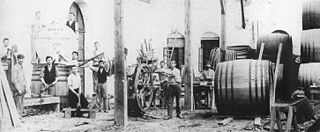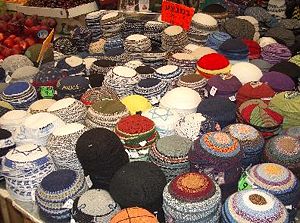Israel
Template:Infobox Israel
The State of Israel (in Hebrew "Medinat Yisra'el", or in Arabic "Dawlat Isrā'īl") is a country in the Southwest Asian Levant, on the southeastern edge of the Mediterranean Sea.
Israel declared its independence in 1948. With a diverse population currently exceeding seven million citizens of primarily Jewish background and religion, it is the world's only Jewish state.
Israel is the only country in the Middle East considered to be a liberal democracy, having a broad array of political rights and civil liberties present. In addition, Israel is considered the most advanced in the region in terms of freedom of the press, commercial law, economic competition, and overall human development.
The land of Israel holds a special place in Jewish religious obligations, encompassing Judaism's most important sites (such as the remains of the First and Second Temples of the Jewish People).
Geography
The name "Israel" is rooted in the Hebrew Bible, Genesis 32:28, where Jacob is renamed Israel after successfully wrestling with an angel of God. The biblical nation fathered by Jacob was then called "The Children of Israel" or the "Israelites". The modern country was named State of Israel, and its citizens are referred to as Israelis in English.
Israel is bordered by Lebanon in the north, Syria and Jordan in the east, and Egypt in the south-west. It has coastlines on the Mediterranean Sea in the west and the Gulf of Eilat (also known as the Gulf of Aqaba) in the south.
During the Six-Day War of 1967, Israel captured the West Bank from Jordan, the Golan Heights from Syria, Gaza Strip (which was under Egyptian occupation), and Sinai Peninsula from Egypt. It withdrew from Sinai by 1982 and from the Gaza Strip by September 12, 2005. The future Palestinian region of the West Bank and the Gaza Strip remains to be determined. East Jerusalem has been under Israeli civil law, jurisdiction and administration since and the Golan Heights since 1981, though they have not been formally annexed.
The sovereign territory of Israel, excluding all territories captured by Israel in 1967, is 8019 square miles (20,770 square kilometres) in area, or slightly smaller than New Jersey in the United States.
Israel is divided east-west by a mountain range running north to south along the coast. Jerusalem sits on the top of this ridge, east of which lies the Dead Sea.
The numerous limestone and sandstone layers of the Israeli mountains allow the water to pour from the west flank to the east. Several springs have formed along the Dead Sea, each an oasis, most notably the oasis at Ein Gedi and Ein Bokek where settlements have developed.
Israel also has a number of large limestone karsts. These caves are around 68°F (20°C), although only one is open to the public. Very common all around the country are small natural caves, that have been used for thousands of years as shelter, housing, storage rooms, barns and churches.
Israel is divided into four main geographical regions: the Israeli Coastal Plain, the central hills, the Jordan Rift Valley, and the Negev Desert.
The coastal plain stretches from the Lebanese border in the north to Gaza in the south, interrupted only by Cape Carmel at Haifa Bay. It is about 25 miles (40km) wide at Gaza and narrows toward the north to about three miles (5km) at the Lebanese border. The region is fertile and humid, has had problems with malaria, and is known for its citrus and viniculture. The plain is traversed by several short streams.
East of the coastal plain lies the central highland. In the north lie the mountains and hills of Galilee; farther to the south are the Samarian Hills with numerous small, fertile valleys; and south of Jerusalem are the mainly barren hills of Judea. The central highlands average 2000 feet (610 meters) in height and reach their highest elevation at Har Meron, at 3963 feet (1208 meters) in Galilee near Safed.
East of the central highlands lies the Jordan Rift Valley, which is a small part of the 4040 mile (6500-kilometer)-long Great Rift Valley. In Israel the Rift Valley is dominated by the Jordan River, the Sea of Galilee (an important freshwater source also known as Lake Tiberias and to Israelis as Lake Kinneret), and the Dead Sea.
The Jordan River, Israel's largest river 200 miles (322km), originates in the Anti-Lebanon Mountains and flows south through the drained Hulah Valley into the freshwater Lake Tiberias. With a water capacity estimated at 106 billion cubic feet (three cubic kilometres), it serves as the principal reservoir for Israel. The Jordan River continues from the southern end of Lake Tiberias (forming the boundary between the West Bank and Jordan) to the highly saline Dead Sea, which is 393 square miles (1020 square kilometres) in size and, at 1309 feet (399 meters) below sea level, is the lowest point in the world.
The Negev Desert comprises approximately 4600 square miles (12,000 square kilometres) more than half of Israel's total land area. Geographically it is an extension of the Sinai Desert, forming a rough triangle with its base in the north near Beersheba, the Dead Sea, and the southern Judean Mountains, and it has its apex in the southern tip of the country at Eilat.
The coastal climate differs from that of the mountainous areas, particularly during the winter. The northern mountains can get cold, wet and often snowy, and even Jerusalem has snow every couple of years. The coastal regions, where Tel Aviv and Haifa are located, have a typical Mediterranean climate with cool, rainy winters and hot, dry summers. January is the coldest month with average temperatures ranging from 43°F to 59°F (6°C to 15°C) ,and July and August are the hottest months at 72°F to 91°F (22°C to 33°C) on average across the state. In Eilat, the desert city, summer daytime-temperatures at times reach 111°F to 115°F (44°C to 46°C). More than 70 percent of the rain falls between November and March. The most cultivated areas receive more than 12 inches (300 millimeters) of rainfall annually; about one-third of the country is cultivable.
Natural hazards include sandstorms during spring and summer, droughts, and periodic earthquakes. Thunderstorms and hail are common throughout the rainy season and waterspouts occasionally hit the Mediterranean coast, capable of causing only minor damage. However, supercell thunderstorms and a true F2 tornado hit the Western Galilee April 4, 2006, causing significant damage and 75 injuries.
Limited arable land and natural fresh water resources pose serious constraints, while the nation must deal with on-going problems of desertification, air pollution from industrial and vehicle emissions, groundwater pollution from industrial and domestic waste, and toxic residue from chemical fertilizers, and pesticides.
Jerusalem has been continuously settled for more than 3000 years and is the location of many sites of historical and religious significance for Jews, Christians, and Muslims, including the Dome of the Rock, the Wailing Wall, the Church of the Holy Sepulchre, and the Tomb of the Virgin Mary. The Old City has the Jewish, Christian, Muslim, and Armenian quarters. Israel's "Basic Law" states that "Jerusalem, complete and united, is the capital of Israel", although the Palestinian Authority sees East Jerusalem as the future capital of Palestine. Metropolitan Jerusalem had a total population of 2,300,000 in 2006, including 700,000 Jews and 1,600,000 Arabs. Tel Aviv had a population of 3,040,400, Haifa had 996,000) and Beersheba had 531,600.
History
Mousterian Neanderthals appear as the earliest human inhabitants , dating from about 200,000 B.C.E. The first anatomically-modern humans in the area were called the Kebarans, conventionally dated from 18,000 B.C.E. to 10,500 B.C.E. but may have arrived as early as 75,000 B.C.E. They were followed by the Natufian culture (c. 10,500 B.C.E. - 8500 B.C.E.), the Yarmukians (c. 8500 B.C.E. - 4300 B.C.E.) and the Ghassulians (carbon dated c. 4300 B.C.E. - 3300 B.C.E.). The Ghassulian economy consisted of extensive cultivation of grains (wheat and barley), intensive horticulture of vegetable crops, commercial production of vines and olives, and a combination of seasonal and nomadic pastoralism. Semitic languages appeared in this area at that time, and people may have begun living in small city-states, one of which was Jericho. The area's location at the center of three trade routes linking three continents made it the meeting place for religious and cultural influences from Egypt, Syria, Mesopotamia, and Asia Minor.
The beginning of Israel
Jewish tradition holds that the Land of Israel has been a Jewish Holy Land and Promised land for four thousand years. The Book of Genesis traces the beginning of Israel to three patriarchs of the Jewish and neighbouring people, Abraham, Isaac and Jacob, the latter also known as Israel from which the name of the land was subsequently derived. Stories of the origins of Israel locate it on the east bank of the Jordan. The stories of Israel move to the west bank with the story of the sacking of Shechem (Genesis 34:1-33), after which the hill area of Canaan is assumed to have been the core of the area of Israel. The likely date for these events is in dispute, although some theories place them somewhere between 2000 B.C.E. and 1600 B.C.E.
Exodus
The Biblical book of Genesis relates how some of the descendents of Israel became Egyptian slaves. Some Bible commentaries place the birth of Moses around 1300 B.C.E. The Exodus of the Israelites from Egypt, led by Moses, and its chronology are much-debated. Some believe that the Exodus took place in the reign of Ramesses II (1279 B.C.E. to 1213 B.C.E.) due to the Egyptian cities named in Exodus (Pithom and Rameses). Evidence for an Israelite presence in Palestine has been found from only six years after the end of the reign of Rameses II, in the Merneptah Stele, documenting military campaigns in Canaan.
Exodus goes on to say that after leaving Egypt, nearly three million Israelites wandered in the desert for a generation, until the Israelites invaded the land of Canaan, destroying cities of Ai, Jericho and Hazor. If Rameses II was Exodus Pharaoh, the conquest of Canaan and the destruction of Jericho and other Canaanite cities would have occurred around 1200 B.C.E., despite the fact that Jericho was unoccupied at this time, having been destroyed at about 1550 B.C.E.
Period of the Judges
Around 1200 B.C.E., the Philistines, Tjekker sea people, and possibly Danites settled along the cost from Gaza in the south to Joppa in the north, and the entire Middle East fell into a "Dark Age" from which it took centuries to recover. In their initial attacks under Joshua, the Hebrews occupied most of Canaan, which they settled according to traditional family lines derived from the sons of Jacob and Joseph (the "tribes" of Israel). No formal government existed and ad hoc leaders, or the "judges" of the biblical Book of Judges, led in times of crisis. Around 1140 B.C.E., the Canaanite tribes tried to destroy the Israelite tribes of northern and central Canaan, but were defeated.
United Kingdom
Wealth returned to the region by the end of the period extending between the collapse of the Mycenaean kingdoms, the Hittite Empire in Anatolia and Syria and the Egyptian Empire in Syria and Palestine, between 1206 and 1150 B.C.E., down to the rise of settled Aramaean kingdoms of the mid tenth century B.C.E., and the rise of the Neo-Assyrian Empire. Trade with Egypt and Mesopotamia recovered, so a new interior trade route opened up. This new route threatened Philistine trade, resulting in friction with the tribes of Israel. Increasing pressure from the Philistines, and other neighboring tribes, caused the Israelites to unite under one king around 1050 B.C.E. Samuel, one of the last of the judges, anointed Saul ben Kish from the tribe of Benjamin as king.
David, who killed the Philistine giant Goliath, was made king upon the death of Saul. David's first action as king was to conquer Jerusalem and declare it the capital of his kingdom. According to Jewish tradition, Mount Moriah is an important place where Abraham bound Isaac and thus the Temple was to be built there. David conquered Jerusalem around 1004 B.C.E., and brought the Ark of the Covenant to the city, which he made the center of his government, and the spiritual nexus of the Jewish people. King David was instructed not to build the Temple, leaving the task to his son Solomon. The concentration of religious ritual at the Temple made Jerusalem a place of pilgrimage and an important commercial center.
King Solomon, who was born in Jerusalem about 1000 B.C.E. and reigned over Israel from about 970 to 928 B.C.E., was the third and final king of the United Monarchy. Solomon's Temple was the first Jewish Temple in Jerusalem. Completed in the tenth century B.C.E., it functioned as a religious focal point for worship and sacrifices in ancient Judaism.
Divided kingdoms
Around 920 B.C.E., Jeroboam led a revolt of the northern tribes, and established the Kingdom of Israel, which seems to have been more developed than its southern neighbour. Rainfall in this area is higher and the agricultural systems more productive. According to the Biblical account, there were 19 separate rulers of Israel, although it seems much less politically stable than Judah, maintaining a form of charismatic leadership by merit and competition between ruling families seem to have depended much more on links with outside powers, Tyre, Aram and Assyria, to maintain their authority. Israel was invaded by Egyptian Pharaoh Sheshonk I (the Biblical Shishak), of the Libyan 22nd Dynasty. The kingdom of Israel appears to have been most powerful in the first half of the ninth century B.C.E., during which time, Omri (885-874 B.C.E.) founded a new dynasty with its capital city at Samaria, with support from the Phoenician city of Tyre. Omri's son and successor contributed 2000 chariots, and 10,000 soldiers to a coalition of states which fought and defeated Shalmaneser III at Qarqar in 853 B.C.E. Twelve years later, Jehu, helped by the kingdom of Aram, centred in Damascus, organised a coup in which Ahab and his family were put to death. The black obelisk of Shalmaneser III, the only surviving portrait of any monarch of either of the two states, records Jehu kneeling to the Assyrian monarch.
Captivity
Judah appealed for Assyrian intervention, to end to domination from its two northern neighbours. This led, in 720 B.C.E. to the fall of Israel to the Assyrians, under Sargon, and the incorporation of Israel into the Assyrian empire. Many people fled south to Judah, whose capital city Jerusalem seems to have grown by over 500 percent at this time.
The problem with the history of the divided monarchy is that the Septuagint, the Hebrew Masoretic text, and Josephus all have different figures, it is unknown if the two kingdoms used the same calendar, and it is unclear whether the number of years reigned refer only to full years or part years.
In 920 B.C.E. the southern Kingdom of Judah had Jerusalem as its capital and was led by Rehoboam, leading to war with Israel, which according to the Bible, continued during the reigns of Abijiah and Asa of Judah, during whose reign Israel penetrated to Ramah, five kilometers north of Jerusalem.
Inhabitants of Judah faced captivity at the hands of the Babylonians under Nebuchadnezzar II in 597 B.C.E., when the Temple of Jerusalem was partly despoiled and a number of the leading citizens were removed. In 586 B.C.E., in the reign of Zedekiah) a fresh rising of the Judaeans occurred, and the city was razed to the ground and a further deportation ensued. Finally, five years later (581 B.C.E.), Jeremiah records a third captivity.
The Second Temple
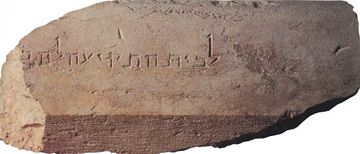
After the overthrow of Babylonia by the Persian Empire, Cyrus the Great gave the Jews permission to return to their native land (in 537 B.C.E.), and more than 40,000 are said to have returned, taking with them the Temple vessels that the Babylonians had taken. Under the spiritual leadership of the Prophets Haggai and Zechariah, the Second Temple was completed. At this time the Holy Land is a sub-district of a Persian satrapy (province). From 444 B.C.E., the Jewish scribes Nehemiah and Ezra led a reformation of Israel, instituting synagogue and prayer services. This was the Classical period of Ancient Greece). The 'Second Temple stood between 516 B.C.E. and 70 C.E. In 428 B.C.E., Samaritans build their temple on Mount Gerizim
Alexander the Great
Alexander the Great defeated the Persian Empire in 331 B.C.E. The Empire of Alexander the Great included Israel, although he did not attack Jerusalem directly, after a delegation of Jews met him and assured him of their loyalty by showing him certain prophecies contained in their writings. After Alexander’s death in 323 B.C.E., a power struggle ensued, the part of his empire that included Israel changed hands at least five times in just over 20 years. Babylonia and Syria were ruled by the Seleucids, and Egypt by the Ptolemies.
Hasmonean Kingdom
The Hasmonean Kingdom (140 B.C.E.–37 B.C.E.), was an autonomous Jewish state in ancient Israel. It was established under the leadership of Simon Maccabaeus, two decades after his brother Judas Maccabeus defeated the Seleucid army during the Maccabee Revolt in 165 B.C.E., a victory that Jews still celebrate in the festival of Hanukkah. The kingdom was the only independent Jewish state to exist in the four centuries after the Kingdom of Judah was destroyed in 586 B.C.E., and was one of the last before the modern state of Israel]]. Judah became an independent state in 141 B.C.E., Herod conquered Judah in 37 B.C.E., and rebuilt the Temple in 19 B.C.E.
Roman occupation
Rome's involvement in the area dated from 63 B.C.E., after the Third Mithridatic War, when Rome made Syria a province. Judea's Hasmonean Kingdom became a client kingdom and then a province of the Roman Empire.
Around 40-39 B.C.E., Herod the Great was appointed King of the Jews by the Roman Senate. Around 4 B.C.E., Jesus and John the Baptist were born. While Pontius Pilate was governor of Iudaea (26-36 C.E.), John the Baptist was beheaded, and Jesus was crucified. Herod Agrippa I, appointed "King of the Jews" by Claudius, ruled from 41-44 C.E., and Herod Agrippa II, who ruled from 48-100 C.E., was the seventh and last of the Herodians.
Iudaea Province was the stage of three major rebellions — the Great Jewish Revolt (66-70 C.E.), the Kitos War (115-117 C.E.), and Bar Kokhba's revolt (132-135 C.E.), after which Hadrian changed the name of the province to Syria Palaestina and Jerusalem to Aelia Capitolina in an attempt to erase the historical ties of the Jewish people to the region. To humiliate the defeated Jews, the Latin name Palaestina was chosen for the area, after the Philistines, whom the Romans identified as the worst enemies of the Jews. From then on the region was known as Palestine.
Jewish presence continues
Nevertheless, the Jewish presence in Palestine remained constant. The main Jewish population shifted from Judeato Galilee. The Mishnah and Jerusalem Talmud, two of Judaism's most important religious texts, were composed during this period. The land was conquered from the Byzantine Empire in 638 C.E. during the initial Muslim conquests. The Hebrew alphabet (niqqud) was invented in Tiberias during this time. The area was ruled by the Omayyads, then by the Abbasids, Crusaders, the Kharezmians and Mongols, before becoming part of the empire of the Mamluk (1260–1516), and the Ottoman Empire in 1517.
Jews living in the Jewish diaspora have emigrated to Israel throughout the centuries. There has been a continual Jewish presence in Jerusalem since 1267. Small waves of immigration occurred during the eighteenth century out of religious motives, famously Menachem Mendel of Vitebsk and 300 of his followers, Judah he-Hasid and over 1000 disciples, and over five hundred disciples (and their families) of the Vilna Gaon known as Perushim. Waves of rabbinical students immigrated in 1808–1809, settling in Tiberias, Safed and then in Jerusalem. In 1860, the old Jewish community in Jerusalem started building neighborhoods outside the walls of the Old City (the first one being Mishkenot Sha’ananim). The first modern agricultural settlement was founded in 1878.
Zionism
The first big wave of modern immigration, or Aliyah, started in 1881 as Jews fled growing persecution, or followed the Socialist Zionist ideas of Moses Hess and others of "redemption of the soil." Jews bought land from individual Arab landholders. After Jews established agricultural settlements, tensions erupted between the Jews and Arabs.
Theodor Herzl (1860–1904), an Austro-Hungarian Jew, founded the Zionist movement. In 1896, he published Der Judenstaat (The Jewish State), in which he called for the establishment of a national Jewish state. The following year he helped convene the first World Zionist Congress. The Second Aliyah (1904–1914) brought an influx of around 40,000 Jews.
In 1917, the British Foreign Secretary Arthur J. Balfour issued the Balfour Declaration that "view[ed] with favour the establishment in Palestine of a national home for the Jewish people." In 1920, Palestine became a League of Nations mandate administered by Britain. Jewish immigration resumed in the third (1919–1923)]] and fourth (1924–1929)]] waves after World War I. Riots in 1929, killed 133 Jews and 116 Arabs.
The rise of Nazism in 1933 led to a Fifth Aliyah (1929-1939). The subsequent Holocaust in Europe led to additional immigration from other parts of Europe. In 1939, the British introduced a white paper which limited Jewish immigration over the course of the war to 75,000 and restricted purchase of land by Jews, perhaps in response to the 1936-1939 Arab revolt in Palestine. Many Jews fleeing to Palestine to avoid death at the hands of the Nazis were intercepted and returned to Europe. The Jewish population in the region increased from 83,790 (11 percent) in 1922 to 608,230 (33 percent) in 1945.
Jewish underground groups
Many Arabs, opposed to the Balfour Declaration, the mandate, and the Jewish National Home, instigated riots and pogroms against Jews in Jerusalem, Hebron, Jaffa, and Haifa. In response, Jewish settlers formed the Haganah in 1921 to protect settlements. Several Haganah members formed the militant group Irgun in 1931, which attacked the British military headquarters, the King David Hotel, which killed 91 people. A further split occurred when Avraham Stern left the Irgun to form Lehi, which was much more extreme, refused any co-operation with the British during World War II, and tried to work with the Germans to secure European Jewry's escape to Palestine.
Partition

In 1947, the British government decided to withdraw from Palestine. The United Nations General Assembly approved the 1947 UN Partition Plan dividing the territory into two states, with the Jewish area consisting of roughly 55 percent of the land, and the Arab area consisting of roughly 45 percent. Jerusalem was to be designated as an international region administered by the UN to avoid conflict over its status. On November 29, 1947, David Ben-Gurion tentatively accepted the partition, while the Arab League rejected it. The Arab Higher Committee immediately ordered a violent three-day strike, attacking buildings, shops, and neighborhoods, and prompting insurgency organized by underground Jewish militias. These attacks soon turned into widespread fighting between Arabs and Jews, this civil war being the first "phase" of the 1948 War of Independence. The State of Israel was proclaimed on May 14, 1948, one day before the expiry of the British Mandate of Palestine. Israel was admitted as a member of the United Nations on May 11, 1949.
1948 war of independence
Over the next few days, approximately 1000 Lebanese, 5000 Syrian, 5000 Iraqi, and 10,000 Egyptian troops invaded the newly-established state. Four thousand Transjordanian troops invaded the Corpus separatum region encompassing Jerusalem and its environs, as well as areas designated as part of the Arab state. Volunteers from Saudi Arabia, Libya and Yemen helped. Israeli forces fought back, and captured significant amounts of territory that had been designated for the Arab state of Transjordan, as well as part of Jerusalem.
After numerous months of war, a ceasefire was declared and temporary borders, known as the Green Line, were instituted. Israel had gained an additional 23.5 percent of the Mandate territory west of the Jordan River. Jordan held the large mountainous areas of Judea and Samaria, which became known as the West Bank. Egypt took control of a small strip of land along the coast, which became known as the Gaza Strip.
Large numbers of the Arab population fled or were expelled from the newly-created Jewish State. This Palestinian exodus is referred to by Palestinians as the Nakba ("disaster" or "cataclysm"). Estimates of the final Palestinian refugee count range from 400,000 to 900,000 with the official United Nations count at 711,000. The unresolved conflict between Israel and the Arab world has resulted in a lasting displacement of Palestinian refugees. The entire Jewish population of the West Bank and Gaza Strip fled to Israel. Over the following years approximately 850,000 Sephardi and Mizrahi Jews fled or were expelled from surrounding Arab countries. Of these, about 600,000 settled in Israel; the remainder went to Europe and the Americas.
Suez crisis
In 1956, Egypt nationalized the Suez Canal, much to the chagrin of the United Kingdom and France. Israel, fearing Egypt's increase in power, staged an attack in the Sinai Desert. Several days later, Britain and France joined the offensive. The United Nations sent peacekeepers, who stayed in the region until 1967.
In 1961, the Nazi war criminal Adolf Eichmann, who had been largely responsible for the Final Solution, the planned extermination of the Jews of Europe, was captured in Buenos Aires, Argentina, by Mossad agents and brought to trial in Israel. Eichmann became the only person ever sentenced to death by the Israeli courts.
The Six-Day War
Tensions arose between Israel and her neighbors in May 1967. Syria, Jordan, and Egypt had been hinting at war and Egypt expelled UN Peacekeeping Forces from the Gaza Strip. When Egypt closed the strategic Straits of Tiran to Israeli vessels, and began massing large numbers of tanks and aircraft on Israel's borders, Israel pre-emptively attacked Egypt on June 5. In the ensuing Six-Day War Israel defeated three large Arab states, conquered the West Bank, Gaza Strip, Sinai Peninsula, and Golan Heights. The Green Line of 1949 became the administrative boundary between Israel and the Occupied Territories. The Sinai was later returned to Egypt following the signing of a peace treaty.
Munich massacre
At the 1972 Munich Olympic Games, Palestinian militants held hostage and killed members of the Israeli delegation. Agents of Israel’s Mossad assassinated most of those who were involved in the massacre. On October 6, 1973, the day of the Jewish Yom Kippur fast, the Egyptian and Syrian armies launched a surprise attack against Israel. Egypt and Syria were repelled, and a number of years of relative calm ensued.
Peace with Egypt
Israeli prime minister Menachem Begin and Egyptian president Anwar Al Sadat signed of the Camp David Accords, and in March 1979, signed the Israel-Egypt Peace Treaty in Washington, DC. Israel withdrew from the Sinai Peninsula and evacuated the settlements established there during the 1970s. It was also agreed to lend autonomy to Palestinians across the Green Line.
Lebanon invaded
On July 7, 1981, the Israeli Air Force bombed the Iraqi nuclear reactor at Osiraq in an attempt to foil Iraqi efforts at producing an atomic bomb. In 1982, Israel launched an attack against Lebanon, which had been embroiled in the civil war since 1975, to defend Israel's northernmost settlements from terrorist attacks. After establishing a 40km barrier zone, the Israel Defense Forces captured Lebanon's capital Beirut, and expelled the Palestinian Liberation Organization from the country. Though Israel withdrew from most of Lebanon in 1986, a buffer zone was maintained until May 2000 when Israel unilaterally withdrew from Lebanon. A Palestinian uprising called the Intifadah began in 1987. Palestinians threw rocks at Israeli soldiers occupying the Gaza Strip and the West Bank. Israelis retaliated, and the violence escalated, resulting in hundreds of deaths. Israel proposed a peace initiative in 1989. This same year saw the beginning of a mass immigration by Soviet Jews.
Gulf War
During the 1991 Gulf War, Iraq hit Israel with 39 Scud missiles, although Israel was not a member of the anti-Iraq coalition and was not involved in the fighting. The missiles did not kill Israeli citizens directly, but there were some deaths from incorrect use of the gas masks provided against chemical attack, one Israeli died from a heart attack following a hit, and one Israeli died from a Patriot missile hit. During the war, Israel provided gas masks for the Palestinians in the West Bank and Gaza. The PLO, however, supported Saddam Hussein. Palestinians in the West Bank and Gaza marched and famously stood on their rooftops while Scud missiles were falling and cheered Saddam Hussein.
Oslo Accords
Yitzhak Rabin, who was elected prime minister in 1992, signed the Oslo Accords with the Palestine Liberation Organization in 1993. In 1994, Jordan made peace with Israel. The initial wide public support for the Oslo Accords began to wane as Israel was struck by an unprecedented wave of attacks supported by the militant Hamas group, which opposed the accords. On November 4, 1995, a Jewish nationalist militant named Yigal Amir assassinated Rabin. Likud’s Benjamin Netanyahu, elected prime minister in 1996, withdrew from Hebron and signed the Wye River Memorandum, giving wider control to the Palestinian National Authority. During Netanyahu's tenure, Israel experienced a lull in attacks by Palestinian groups, but his government fell in 1999 to Ehud Barak of One Israel.
Barak withdrew from Lebanon in 2000, to frustrate Hezbollah attacks on Israel by forcing them to cross Israel's border. Barak and Palestine Liberation Organisation head Yassir Arafat negotiated with U.S.President Bill Clinton at a summit at Camp David in July 2000. Barak offered formula to create a Palestinian State, but Arafat rejected this deal. Palestinians began a second uprising, known as the Al-Aqsa Intifadah, just after the leader of the opposition Ariel Sharon visited the Temple Mount in Jerusalem.
Gaza withdrawal
Ariel Sharon was elected prime minister in March 2001, and was subsequently re-elected, along with his Likud party in the 2003 elections. Sharon initiated an Israeli withdrawal from the Gaza Strip, in 2005.
Israel began building the Israeli West Bank Barrier to defend against attacks by armed Palestinian groups. The barrier effectively annexes 9.5 percent of the West Bank, and creates hardships for Palestinians living near it. The international community and the Israeli far-left have criticised the wall, but it has significantly reduced the number of terrorist attacks against Israel.
Hamas, an Islamic militant group fighting to replace the state of Israel with an Islamic state, won a surprise victory in the Palestinian legislative election, in January 2006, taking 76 of the 132 seats in the chamber, while the ruling Fatah party took 43.
After Ariel Sharon suffered a severe hemorrhagic stroke, the powers of the office were passed to Ehud Olmert, who was designated the "Acting" Prime Minister. On April 14, 2006, Olmert was elected Prime Minister after his party, Kadima, won the most seats in the 2006 elections.
On June 28, 2006, Hamas militants dug a tunnel under the border from the Gaza Strip and attacked an Israel Defense Forces post, capturing an Israeli soldier and killing two others. Israel bombarded Hamas targets as well as bridges, roads, and the only power station in Gaza.
A conflict between Palestinian militant group Hezbollah and Israel began July 12, 2006, with a cross-border Hezbollah raid and shelling, which resulted in the capture of two and killing of eight Israeli soldiers. Israel initiated an air and naval blockade, airstrikes across much of the country, and ground incursions into southern Lebanon. Hezbollah continuously launched rocket attacks into northern Israel and engaged the Israeli Army on the ground with hit-and-run guerrilla attacks. A ceasefire came into effect on August 14, 2006. The conflict killed over one thousand Lebanese civilians, 440 Hezbollah militants, and 119 Israeli soldiers, as well as 44 Israeli civilians, and caused massive damage to the civilian infrastructure and cities of Lebanon and damaged thousands of buildings across northern Israel, many of which were destroyed.
Government and politics
Israel is a democratic republic with universal suffrage that operates under a parliamentary system.
The president of Israel is head of state, serving as a largely ceremonial figurehead. The president selects the leader of the majority party or ruling coalition in the Knesset as the prime minister, who serves as head of government and leads the cabinet. For a short period in the 1990s, the Prime Minister was directly elected. This change was not viewed a success and was abandoned. The 2007 president was Moshe Katsav, though the acting president was Dalia Itzik; the prime minister was Ehud Olmert.
Israel's unicameral]] legislative branch is a 120-member parliament known as the Knesset. Membership in the Knesset is allocated to parties based on their proportion of the vote. Elections to the Knesset are normally held every four years, but the Knesset can decide to dissolve itself ahead of time by a simple majority, known as a vote of no confidence. Twelve parties held seats in 2007.
Israel's judiciary is made of a three-tier system of courts. At the lowest level are magistrate courts, situated in most cities. Above them are district courts, serving both as appellate courts and as courts of first instance, situated in Jerusalem, Tel Aviv, Haifa, Be'er Sheva and Nazareth. At the top is the Supreme Court of Israel seated in Jerusalem, which serves a dual role as the highest court of appeals and as the body for a separate institution known as the High Court of Justice. This court has the unique responsibility of addressing petitions presented by individual citizens. The respondents to these petitions are usually governmental agencies. A committee composed of Knesset members, Supreme Court Justices, and Israeli Bar members carries out the election of judges. The Courts Law requires judges to retire at the age of 70. The Chief Justice of the Supreme Court, with the approval of the Minister of Justice, appoints registrars to all courts.
Israel is not a member of the International Criminal Court as it fears it could lead to prosecution of Israeli settlers in the disputed territories.
Legal system
Israel has not completed a written constitution. Its government functions according to the laws of the Knesset, including the "Basic Laws of Israel", of which there are presently 14. These are slated to become the foundation of a future official constitution. In mid-2003, the Knesset's constitution, law, and justice committee began drafting an official constitution.
Israel's legal system mixes influences from Anglo-American, continental and Jewish law, as well as the declaration of the State of Israel. As in Anglo-American law, the Israeli legal system is based on the principle of precedent, it is an adversarial system, not an inquisitorial one, in the sense that the parties (for example, plaintiff and defendant) bring the evidence before the court. The court does not conduct any independent investigation.
Court cases are decided by professional judges. Additional continental law influences can be found in the fact that several major Israeli statutes (such as the contract law) are based on civil law principles. Israeli statute body is not comprised of codes, but of individual statutes. However, a civil code draft has been completed, and is planned to become a bill.
Religious tribunals (Jewish, Muslim, Druze and Christian) have exclusive jurisdiction on annulment of marriages.
Human rights
The Declaration of the Establishment of the State of Israel included a broad commitment to uphold the rights of its citizens. However, like many democracies, Israel often struggles with issues of minority rights, especially when it comes to the often contentious issues surrounding the treatment of Israel's large Arab minority, which constitutes 15 percent of Israel's population.
One of Israel's Basic Laws, that on human dignity and liberty, serves to defend human rights and liberties. Amnesty International has been highly critical of Israel's policies, but in 2006, Freedom House rated political rights in Israel as "1" (1 representing the most free and 7 the least free rating); civil liberties as "2". Freedom House classified Israel as "free," and most other countries in the Middle East as "Not Free". However, areas controlled by Israel through military occupation but not considered within the country's main territory were rated as "6," "5," and "Not Free" (and territories administered by the Palestinian Authority were rated as "5", "5", and "Partly Free").
Meanwhile, Sephardi Jews "have long charged that they suffered social and economic discrimination at the hands of the state's Ashkenazi establishment." B’tselem, the Israeli human rights organization, has stated that Israel has created in the West Bank a regime of separation based on discrimination, applying two separate systems of law in the same area and basing the rights of individuals on their nationality. Such criticism has also led to Israel's press being ranked as most free in the region.
Military
Israel's military consists of a unified Israel Defense Forces, known in Hebrew by the acronym Tzahal. There are other paramilitary agencies that deal with different aspects of Israel's security (such as Israel Border Police and Shin Bet). The Israel Defense Force is one of best-funded military forces in the Middle East and ranks among the most battle-trained armed forces in the world, having been involved in five major wars and numerous border conflicts. It relies heavily on high technology weapons systems, some developed and manufactured in Israel for its specific needs, and others imported (largely from the United States).
Most Israeli men and women are drafted into the military at age 18. Immigrants sometimes volunteer to join. Most Israeli Arabs are not conscripted because of a possible conflict of interests, due to the possibility of war with neighbouring Arab states. Compulsory service is three years for men, and two years for women. Men studying full-time in religious institutions can get a deferment from conscription. Most Haredi Jews extend these deferments until they are too old to be conscripted, a practice that has fueled much controversy in Israel.
While Israeli Arabs are not conscripted, they are allowed to enlist voluntarily. The same policy applies to the Bedouin and many non-Jewish citizens of Israel. After compulsory service, Israeli men become part of the reserve forces, and are usually required to serve several weeks every year as reservists until their 40s.
Nuclear capability
The International Atomic Energy Agency has stated outright that it believes Israel to possess nuclear weapons,an assertion the Israeli government has neither affirmed nor denied. Since the middle of the twentieth century, the Negev Nuclear Research Center has been operational and capable of producing weapons grade nuclear material. Although the size of nuclear arsenal is debated, it is generally believed that Israel, which is not a signatory of the Nuclear Non-Proliferation Treaty, possesses at least 100 devices.
Israel leads the Middle East in medium-range ballistic missile development. The Jericho series of ballistic missile was begun in the 1970s, with three major designs built to date. The latest missile design, the Jericho III (based on the "Shavit" booster), has a conservative range estimate of 4500km. Israel maintains a fleet of Dolphin class submarines, widely suspected of being armed with Israeli made medium range (1450km) cruise missiles capable of carrying nuclear warheads.
Economy
Israel is the most industrially and economically developed country in the Middle East. Israel's economy was originally based on a socialist model, but has developed into a technologically advanced market economy with substantial government participation. Despite limited natural resources, Israel has intensively developed its agricultural and industrial sectors over the past 20 years. Israel is largely self-sufficient in food production except for grains and beef.
Israel usually posts sizable current account deficits, which are covered by large transfer payments from abroad and by foreign loans. Israel possesses extensive facilities for oil refining, diamond polishing, and semiconductor fabrication. Roughly half of the government's external debt is owed to the United States, and a large fraction of that is held by individual investors, via the Israel Bonds program. The state can borrow at competitive and sometimes below-market rates.
The influx of Jewish immigrants from the former Soviet Union topped 750,000 during the period 1989–1999. Many of them were highly educated, adding scientific and professional expertise of substantial value. The influx, coupled with the opening of new markets at the end of the Cold War, energized Israel's economy, which grew rapidly in the early 1990s. But growth began slowing in 1996 when the government imposed tighter fiscal and monetary policies and the immigration bonus petered out. Those policies brought inflation down to record low levels in 1999. Twenty-four percent of Israel's workforce holds university degrees, ranking Israel third in the industrialized world after the United States and Netherlands. Twelve percent hold advanced degrees.
Some land is privately owned and some is public property. Israel has a system of kibbutzim — cooperative farms in which property is collectively owned. Residents share chores, and receive housing, medical care, and education instead of wages. There are moshav farming communities in which each family owns a house and is responsible for an area of land, while products are sold collectively. According to the World Bank, Israel has the best regulations for businesses and strongest protections of property rights in the Greater Middle East.
Science and technology
Israeli science is well known for its military technology, as well as its work in genetics, computer sciences, electronics, optics, engineering, agriculture, physics, and medicine. Biologists Avram Hershko and Aaron Ciechanover shared the Nobel prize for chemistry in 2004. Israeli-American psychologist Daniel Kahneman won the 2002 prize in economics, andRobert Aumann won the 2005 economics prize.
Israel's limited natural resources and strong emphasis on education have also played key roles in directing industry towards high technology fields. As a result of the country’s success in developing cutting edge technologies in software, communications and the life sciences, Israel is frequently referred to as a second Silicon Valley.
Israel receives more venture capital investment than any country in Europe, and has the largest number of start-up companies in the world after the United States. Israel produces more scientific papers per capita than any other nation, boasts one of the highest per capita rates of patents filed, and is ranked third in research and development spending.
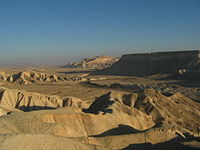
Tourism in Israel includes a rich variety of historical and religious sites in the Holy Land, as well as modern beach resorts, archaeological tourism, heritage tourism, and ecotourism.
Exports totalled $42.86-billion in 2006. Export commodities included machinery and equipment, software, cut diamonds, agricultural products, chemicals, textiles and apparel. Export partners included the U.S. 36.5 percent, Belgium 8.7 percent, and Hong Kong 5.6 percent.. Imports totalled $47.8-billion in 2006. Import commodities included raw materials, military equipment, investment goods, rough diamonds, fuels, grain, and consumer goods. Import partners included US 13.4 percent, Belgium 10.1 percent, Germany 6.4 percent, UK 5.7 percent, Switzerland 5.5 percent, China 4.2 percent.
As Israel has liberalized its economy and reduced taxes and spending, the gap between the rich and poor has grown. As of 2005, 20.5 percent of Israeli families (and 34 percent of Israeli children) are living below the poverty line, though around 40 percent of those are lifted above the poverty line through transfer payments.
Israel's per capita GDP in 2005 (purchase power parity) was $26,200 (28th in the world). As Israel has liberalized its economy and reduced taxes and spending, the gap between the rich and poor has grown. The unemployment rate in 2007 was 7.6 percent.
Demographics
The population in 2007 was 7,150,000. As of 2004, 224,200 Israeli citizens lived in the West Bank, around 180,000 Israelis lived in East Jerusalem, and about 8500 Israelis lived in the Gaza Strip, prior to their forcible removal in the summer of 2005 as part of Israel's unilateral disengagement plan. Life expectancy for the whole population was 79.59 years
Ethnicity
According to Israel's Central Bureau of Statistics, as December 2006, 76 percent of the population were ethnic Jews, 20 percent Arabs, and 4 percent "others". Among Jews, 68 percent were Israeli-born, mostly second or third-generation Israelis, and the rest were foreign-born — 22 percent from Europe and the Americas, and 10 percent from Asia and Africa, including the Arab countries.
Traditionally, Jews are grouped into: Ashkenazim, Jews whose ancestors came from Germany, France, and Eastern Europe; Sephardim, those who settled in Israel from Morocco, Turkey, North Africa and the Mediterranean area, and are descendents of migrants from Spain and Portugal; Italkim, those from central Italy; Mizrahim, from Iran, Iraq, Yemen, and Syria; Beta Israel, from Ethiopia; and Indian Jews. Those with origins in Muslim and Arab lands are commonly called Sephardi by their Ashkenazi counterparts.
Arabs in Israel include descendants of those who remained within Israel's borders during the 1948 Arab-Israeli War, Palestinians who immigrated to Israel (especially since 1993) as well as Druze and Bedouins. About 9 percent of Israeli Arabs are Christians of various denominations, mostly Catholics and Orthodox.
Relations between Jews and Arabs are antagonistic, since each side sees the other as the aggressor. Relations within the Jewish community itself have been problematic. The Orthodox and ultra-Orthodox oppose compromise with the Palestinians and want a more strictly religious state.
Religion
Israel was founded to provide a national home, safe from persecution, to the Jewish people. Although Israeli law explicitly grants equal civil rights to all citizens regardless of religion, ethnicity, or other heritage, it gives preferential treatment to Jews who seek to immigrate to Israel as part of a governmental policy to increase the Jewish population. The criteria set forth by the Law of Return are controversial, in that it disqualifies individuals who are ethnically Jewish but who converted to another religion, and in that it grants immigrant status to individuals who are not ethnically Jewish but are related to Jews.
A total of 76.1 percent of Israelis are Jewish, 16.2 percent are Muslim, 2.1 percent are Christian, 1.6 percent are Druze, and 3.9 percent unclassified.
Roughly 12 percent of Israeli Jews defined as haredim (ultra-orthodox religious); an additional 9 percent are "religious"; 35 percent consider themselves "traditionalists" (not strictly adhering to Jewish Halakha); and 43 percent are "secular" (termed "hiloni"). Among the seculars, 53 percent believe in God. However, 78 percent of all Israelis participate in a Passover seder. Israelis tend to define their religious affiliation by degree of their religious practice.
Among Arab Israelis, 82.6 percent were Muslim, 8.8 percent were Christian and 8.4 percent were Druze. There is also a small community of Ahmadi Muslims in the country.
There are 14 diverse Buddhist groups active in Israel, catering to Israeli Jubus as well as a tiny number of Vietnamese Buddhists who came to Israel as refugees. A small Hindu presence exists, including Vaishnavite Krishna Consciousness devotees, Brahma Kumaris, and others. There are small numbers of Ismailis and Sikhs. The Bahá'í world centre is situated in Haifa, attracting pilgrims from all over the world. Apart from a few hundred staff, Bahá'ís do not live in Israel.
Language
Israel has two official languages: Hebrew, the state language spoken by most people; and Arabic, which is spoken by the Arab minority and by some members of the Mizrahi Jewish community. English is studied in school and is spoken by most as a second language. Other languages include Russian, Yiddish, Ladino, Romanian, Polish, French, Italian, Dutch, German, Amharic and Persian. American and European popular television shows are commonly presented. Newspapers can be found in all languages listed above as well as others.
Men and women
Women work in many fields. Israel elected a woman prime minister, Golda Meir, in 1969. Women are required to serve in the armed forces, but are not permitted combat. While under the Orthodox tradition, women and men live separate lives, and women are excluded from many traditional activities, women are generally accorded equal status to men. On kibbutzim, what labor was divided without respect to gender, women gravitated toward the kitchen and in child care.
Marriage and the family
Arranged marriages are uncommon, but there are social taboos against intermarriage, and it is illegal for a Jew to marry a non-Jew in Israel. It is unusual for an observant Jew to marry someone secular. Divorce is legal, but under Orthodox Jewish law, men may prevent their ex-wives from remarrying. If the woman enters into another relationship, the courts do not recognize it, and any children are considered illegitimate, and cannot marry in Israel. The nuclear family is the most common domestic unit, with grandparents sometimes included. In the original kibbutz system, the husband and wife lived separately, but it became more common for children to live with their parents.
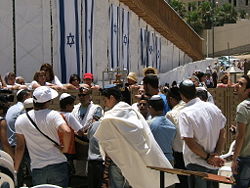
The mother takes responsibility for raising the baby, helped by the extended family. Jewish boys are circumcised eight days after birth. Collective child-care is common, especially for mothers who work outside the home. In kibbutzim, they stay separately from their parents, and usually see them only at night or on weekends. Children are not strictly disciplined. Arab boys and girls are raised separately, and girls are expected to help more with domestic chores.
According to Jewish law, when children reach the age of maturity (12 years for girls, 13 years for boys) they become responsible for their actions. At this point a boy is said to become “Bar [[Mitzvah” ("one to whom the commandments apply"); a girl is said to become “Bat Mitzvah”. Before this age, all the child's responsibility to follow Jewish law and tradition lies with the parents. After this age, the children are privileged to participate in all areas of Jewish community life and bear their own responsibility for Jewish ritual law, tradition, and ethics.
Education
Israeli pupils stay at school longest in the Greater Middle East and Western Asia. The education system consists of three tiers: primary education (grades 1-6), middle school (grades 7-9), then high school (grades 10-12). Compulsory education is from grades 1 to 9. The secondary education mostly consists of preparation for the Israeli matriculation exams (bagrut). The exams consist of mandatory subjects (Hebrew, English, mathematics, religious education, civics and literature), and some optional (chemistry, music, French). In 2003, 56.4 percent of Israeli grade 12 students received a matriculation certificate: 57.4 percent in the Hebrew sector and 50.7 percent in the Arab
Any Israeli with a full matriculation certificate can proceed to higher education. Institutions generally require a certain grade average, as well as a good grade in the psychometric exam (similar to the American SAT). As all universities (and some colleges) are subsidized by the state, students pay only a small part of the actual cost as tuition. Israel has eight universities and several dozen colleges. According to Webometrics (2006), of the top 10 universities in the Middle East, seven out of 10 are in Israel, including the top four. The archaeology of Israel is researched intensively in the universities of the region and also attracts considerable international interest on account of the region's Biblical links.
Class
Most people in Israel have a similarly comfortable standard of living, although the majority of the poor are Palestinian, as are recent immigrants from Africa and Eastern Europe.
Culture
The culture of Israel is incredibly diverse, inseparable from the long history of Judaism and Jewish history which preceded it and from the local (Palestine/Land of Israel) traditions, whilst taking into account the cultures of the countries of the many millions of Jews who moved to Israel from around the globe. The government encourages and supports the arts.
Regarding etiquette, Israelis are very informal, and their standards would, in other countries, be considered rude. The words "please" and "thank you" are used selectively. Arabs can be affectionate, but in Arab society, men and women are often separated socially.
Architecture
Israel's architecture is diverse, including a good deal of Islamic architecture, dating from 1250 to 1517. Most Israelis live in modern high-rise apartments. Some Jewish settlers in Palestinian territory, and many Palestinians, live in shacks, unfinished houses, or other modest dwellings.
Art
Although artist colonies in Safed, Jaffa, and Ein Hod have faded in numbers and importance since the 1970s, Israeli painters and sculptors continue to exhibit and sell their works worldwide. Tel Aviv, Herzliya, and Jerusalem have excellent art museums, and many towns and kibbutzim have smaller high-quality museums. The Israel Museum in Jerusalem houses the Dead Sea Scrolls along with an extensive collection of Jewish religious and folk art. The Museum of the Diaspora is located on the campus of Tel Aviv University. It should be noted that Israel has the highest number of museums per capita of any country in the world.
Cuisine
Jewish cuisine isn't one unified cuisine, but rather a collection of international cookery traditions, loosely linked by kashrut, the Jewish dietary laws. The sheer age of the worldwide Jewish diaspora has brought all sorts of foods into Jewish kitchens.
Under Jewish laws, certain foods, notably pork and shellfish, are forbidden. Other foods, particularly wine and bread, are associated with Jewish rituals. Meat may not be combined with dairy in the same dish, and anything that contains animal blood is not kosher.
Different ideologies among Jewish groups regarding what constitutes kosher foods, as well as personal preferences, play a role in any one Jewish cook's conformity to the religious dietary rules. In addition, regional differences in the availability of ingredients and culture differences in how food is prepared and presented influence the geographic spectrum of Jewish cooking.
A number of soups are more or less characteristically Jewish. The soup into which kneidlach (matzo balls or dumplings) are put, is the dish used most often on Saturdays, holidays, and other special occasions, particularly at Passover. The kneidlach in most cases are made by combining matzo meal (ground matzos) eggs, water, melted fat, pepper and salt. This mixture is then rolled into balls simmered in water and then put into soup. Sometimes kneidlach are fried in fat or cooked with pot roast. Another kind of kneidlach, made from mashed potatoes put into warm milk, formed a well-liked soup among Lithuanian Jews. Falafel, ground chickpeas mixed with onions and spices formed into balls and fried, are served in pita bread. Other dishes include tabuleh (a salad of bulgar wheat and chopped vegetables), hummus (chickpea paste), grilled meats, and eggplant. Cumin, mint, garlic, onion, and black pepper are used for flavoring. Baklava , which consists of flaky dough layered with honey and nuts, is a popular dessert. Coffee is extremely strong and thick and served in small cups. The Sabbath, observed on Saturday, is ushered in on Friday evening with a family meal including an egg bread called challah. On Rosh Hashana, the Jewish New Year, sweet foods are eaten, symbolizing hope for a sweet coming year. Yom Kippur is a a fast day. The meal the night before concentrates on relatively bland foods, so fasters will not become too thirsty. During Passover, Jews abstain from eating all leavened foods (bread, pasta, etc.). Instead they eat matzoh ,a flat, crackerlike bread, is in memory of the Exodus from Israel, when the Jews could not wait for their bread to rise, and so carried it on their backs to bake in the sun.
Wine
Israel has wineries numbering in the hundreds and ranging in size from small boutique enterprises making a few thousand bottles per year to the largest producing over ten million bottles per year. Wine has been produced in Israel since Biblical times. The modern Israeli wine industry was founded by Baron Edmond James de Rothschild, owner of the famous Bordeaux Chateau Château Lafite-Rothschild. In 1882 he supported the new wave of Jewish immigrants by sponsoring their efforts to start a viable wine industry. Israel's move toward producing quality wines really began with one special bottle of wine - Carmel Special Reserve 1976 (released in 1980). This wine was Israel’s first serious ‘fine’ wine.
In the 1980s the quality revolution began in Israel, heralded by the formation of the Golan Heights Winery in 1983. Importing expertise from California, using state of the art technology and high altitude, cooler vineyards, the Golan led the country to a new dawn of quality wine. They won a host of gold medals and a number of trophies at the IWSC in London and Vinexpo in Bordeaux - in particular with their premier label, Yarden. Starting in the 1990s and continuing in the 2000s there has been an explosion of new boutique wineries throughout Israel. The most famous of these is Domaine du Castel, situated in the Judean Hills, west of Jerusalem. Castel wines were chosen as Decanter Wine of the Month on no less than three occasions. Israel's main wine growing areas remain the traditional coastal regions of Sharon & Shimshon, but the best quality wines are coming from the Upper Galilee, Golan Heights, Judean Hills & Ramat Arad.
Clothing
Men wear yarmulkes , sometimes called “kippah” which are skullcaps, for prayer. More observant men wear them at all times. Conservative Jewish men wear black hats, whereas liberal Jews wear white crocheted caps. In the strictest Orthodox communities, men dress in black and wear long sidelocks. The majority of the population, wear Western-style clothes. Many Arabs wear traditional Muslim dress — a turban or other headdress and long robes for men, and a long robe that covers the head and the entire body for women.
Literature
Israeli literature is mostly written in Hebrew and the history of Israeli literature is mostly the product of the revival of the Hebrew language as a spoken language in modern times. Since the middle of the nineteenth century, the Hebrew language was increasingly used for speaking as well as writing modern forms of prose, poetry and drama. Every year thousands of new books are published in Hebrew and most of them are original to the Hebrew language. Shmuel Yosef Agnon won the Nobel Prize in literature in 1966.
Media
Israelis are avid newspaper readers and there is an average daily circulation of 600,000 copies out of a population of approximately seven million. Major daily papers are published in Hebrew, Arabic, English and Russian while many others come in French, Polish, Yiddish, Hungarian, and German.
Music
Israeli music is diverse and combines elements of both western and eastern music. It tends toward eclecticism and contains a wide variety of influences from today's Jewish diaspora. It also makes use of modern cultural importation. Hassidic songs, Asian and Arab pop, especially Yemenite singers, hip hop and heavy metal are all part of the musical scene.
Israel's canonical folk songs often deal with Zionist hopes and dreams and glorify the life of idealistic Jewish youth who intend on building a home and defending their homeland. These are usually known as "Songs of the land of Israel".
Israel is well-known for its famous classical orchestras and the Israeli Philharmonic Orchestra under the management of Zubin Mehta has a worldwide reputation. Dudu Fisher, Itzhak Perlman and Pinchas Zukerman are some of the more renowned classical musicians from Israel. Also well-known is the Jerusalem Symphony, an orchestra associated with the Israel Broadcasting Authority, as do other musical ensembles. Almost every municipality has a chamber orchestra or ensemble, many of which boast the talents of gifted performers who arrived in the 1990s from the countries of the former Soviet Union.
Klezmer , a form of Jewish music that originated in Eastern Europe during the seventeenth century, is a blend of drums, violins, clarinets, keyboards, and tambourines that is common at weddings.
Music styles popular in Israel include pop, rock, heavy metal, hip hop and rap, trance (especially Goa trance and psychedelic trance), Oriental Mizrahi music and ethnic music of various sorts. Israel has won the Eurovision Song Contest three times (1978, 1979, 1998).
Performing arts
The traditional folk dance of Israel is the Hora, originally an Eastern European circle dance. It is the most popular of Israeli folk dances, and is usually performed to Israeli folk songs, typically to the music of Hava Nagila
Israeli folk dancing today is choreographed for recreational as well as performance dance groups. The Palestinian population's folk dance is the Dabke, a dance of community, often performed at weddings and other joyous occasions, with various versions in different villages and cities.
Modern dance in Israel is a flourishing field, and several Israeli choreographers such as Ohad Naharin are considered to be among the most versatile and original international creators working today. Famous Israeli companies include the Batsheva Dance Company and the Bat-Dor Dance Company.
There is great public interest in the theatre; the repertoire covers the entire range of classical and contemporary drama in translation, as well as plays by Israeli authors. Of the three major repertory companies, the most famous, Habima Theater, was founded in 1917. Jewish theater is traditionally melodramatic, although contemporary productions adopt Western theatrical conventions and deal with social issues. Productions are staged in Russian and English as well as in Hebrew and Arabic. The film industry, also thriving, is best known for its documentaries, including Yaakov Gross's Pioneers of Zion , produced in 1995, and Toward Jerusalem , Ruth Beckermann's 1992 production.
Sports
Sports in Israel, as in other countries, are an important part of the national culture. The Israeli sporting culture is much like that of European countries. Israeli athletics go back as far as before the establishment of the state of Israel. While football (soccer) and basketball are considered the most popular sports in Israel, the nation has attained achievements in other sports, such as American football, handball and athletics. Israelis are also involved in hockey, rugby, and, as exemplified by Israeli born Sagi Kalev, bodybuilding. To date, Israel has won six Olympic medals.
ReferencesISBN links support NWE through referral fees
- Kitchen, K. A. 2003. On the reliability of the Old Testament. Grand Rapids, Mich: W.B. Eerdmans. ISBN 0802849601
- Finkelstein, Israel, and Neil Asher Silberman. 2001. The Bible unearthed: archaeology's new vision of ancient Israel and the origin of its sacred texts. New York: Free Press. ISBN 0684869128
- Isserlin, B. S. J. 1998. The Israelites. New York, N.Y.: Thames and Hudson. ISBN 0500050821
- Dever, William G. 2003. Who were the early Israelites, and where did they come from? Grand Rapids, Mich: William B. Eerdmans Pub. Co. ISBN 0802809758
- Kirsch, Jonathan. 2000. King David: the real life of the man who ruled Israel. New York: Ballantine Books. ISBN 0345432754
- Benzion Dinur, "The Messianic Fermentation and Immigration to the Land of Israel from the Crusades until the Black Death, and Their Ideological Roots," in Benzion Dinur, Historical Writings (Jerusalem: Mosad Bialik, 1975), vol. ii. , Elhanan Reiner, Pilgrims and Pilgrimage to the Land of Israel, 1099–1517, doctoral dissertation, Hebrew University of Jerusalem, 1988.
- Oren, Michael B. 2002. Six days of war: June 1967 and the making of the modern Middle East. Oxford: Oxford University Press. ISBN 0195151747
- Kohen, Asher, and Bernard Susser. 2000. Israel and the politics of Jewish identity: the secular-religious impasse. Baltimore, Md: Johns Hopkins University Press. ISBN 0801863457
- Heller, Joseph. 2000. The birth of Israel, 1945-1949 Ben-Gurion and his critics. Gainesville: University Press of Florida. ISBN 0813022630
- Said, Edward W. 2002. The end of the peace process: Oslo and after. London: Granta. ISBN 1862075239
External links
- Israel Countries and Their Cultures, accessed May 11, 2007.
- Israel World Factbook 2007, accessed May 12, 2007.
- The Jewish History Resource Center The Hebrew University of Jerusalem, accessed May 12, 2007.
- Israel and Palestinian Territories BBC News Country Profile,accessed May 12, 2007.
- Israel Jewish Virtual Library, accessed May 12, 2007.
- Encyclopaedia Britannica, Israel - Country Page Encyclopaedia Britannica Online, accessed May 12, 2007.
- Israel US State Department, accessed May 12, 2007.
- Israel Columbia University Libraries, accessed May 12, 2007.
- Israel Lexicon Ynet News.com, accessed May 12, 2007.
- Israel: A focus beyond the conflict Israel21c, accessed May 12, 2007.
- Israel Hutchinson Country Facts, accessed May 12, 2007.
- Israel information Middle-East-Info.org, accessed May 12, 2007.
Credits
New World Encyclopedia writers and editors rewrote and completed the Wikipedia article in accordance with New World Encyclopedia standards. This article abides by terms of the Creative Commons CC-by-sa 3.0 License (CC-by-sa), which may be used and disseminated with proper attribution. Credit is due under the terms of this license that can reference both the New World Encyclopedia contributors and the selfless volunteer contributors of the Wikimedia Foundation. To cite this article click here for a list of acceptable citing formats.The history of earlier contributions by wikipedians is accessible to researchers here:
The history of this article since it was imported to New World Encyclopedia:
Note: Some restrictions may apply to use of individual images which are separately licensed.
